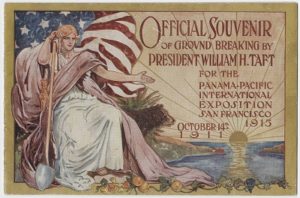
This week in history, the World’s Fair opened in San Francisco, California. While many new inventions were unveiled throughout the coming weeks, one of the main attractions was the airplane. Even more than 10 years after the first flight by the Wright Brothers, many Americans had not seen an airplane until coming to the fair, much less having the opportunity to fly in one. And many exhibitionists attended the fair with their planes in tow to draw in the crowds.
For example, fairgoers gathered to see Lorraine Collett the Sun-Maid Raisin Girl, shower the crowd with raisins from her plane every day. While Allan and Malcolm Loughead, of the Lockheed aviation company, offered adventurous fairgoers a 10-minute flight over San Francisco Bay in their hydroplane. Even more daring was Lincoln Beachey who performed loops and spirals in his biplane until his unfortunate death on March 14, 1915. And Art Smith, who performed at night with phosphorous flares attached to his plane’s wings(1).
Even though these professionals performed many new, and never-before-seen feats, the danger they were exposed to increased, every time they took flight. At this time, retractable landing gear needing critical corrosion protection was not invented; and even important, standard repairs had not been established. While the Wright Brothers developed landing wheels when doing work for the US Army in 1910, many airplanes still used wooden or metal landing skids to glide back onto the ground or sand(2).
The advancements and regulations put in place today, continually encourage OEMs and MROs to improve designs in safety, efficiency, and environmental impact.
Learn more about the top draws to the World’s Fair at History website.

 Chinese (Simplified)
Chinese (Simplified)  English (UK)
English (UK)  French
French  German
German  Spanish
Spanish  Swedish
Swedish 